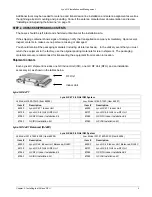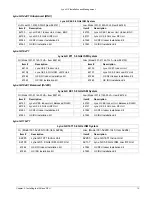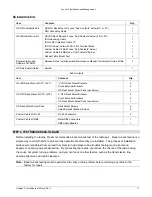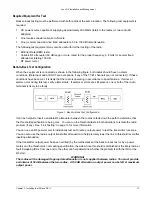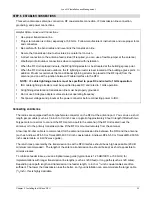
Lynx.GX Installation and Management
STEP 6. ESTABLISH CONNECTIONS
This section discusses antenna connection, RF coaxial cable connection, IF transmission line connection,
grounding, and power connections.
Helpful Hints—Lines and Connections
▪
Use proper transmission line.
▪
Proper termination is critical, especially at 5.8 GHz. Follow manufacturer’s instructions and use proper tools
and connectors.
▪
Be careful with the bend radius and never kink the transmission line.
▪
Secure the transmission line to structures; be careful not to crush.
▪
A direct connection to the antenna feed is ideal (if required, you can use a flexible jumper at the antenna).
▪
Weatherproof all outdoor connections when completed with installation.
▪
When the RF Unit is placed indoors, the RF lightning arrestor is best located at the building egress point.
▪
When the RF Unit is placed outdoors, the IF lightning arrestor is best located at the building egress point. In
addition, Proxim recommends that an additional lightning arrestor be placed at the RF input (from the
antenna) and one at the junction between IF cable interface to the RFU
NOTE: IF cable lightning arrestors must be specified to pass DC and rated to 1 GHz operation.
▪
IDU cable lightning arrestors must be specified to pass DC and rated to 1 GHz operation.
▪
All lightning arrestors and transmission line must be properly grounded.
▪
Do not use 90-degree adapters unless rated at operating frequency.
▪
Test power voltages and pinouts at the power connector before connecting power to IDU.
Connecting an Antenna
The radios are equipped with an N-type female connector on the RFU at the antenna port. You can use a short
length jumper cable (such as 1/4-inch to 1/2-inch coax or pigtail of approximately 6 feet in length) fitted with two
N-type male connectors to connect the RFU antenna port to the antenna (if the RFU is located near the
antenna) or to the primary transmission line (if the RFU is mounted remotely from the antenna).
A low-loss 50-ohm cable is recommended for the antenna transmission line between the RFU and the antenna
(such as Andrew LDF4-50 or Times LMR-600 1/2-inch coaxial cable, Andrew LDF4.5-50 or Times LMR-900 5/8-
inch coaxial cable, or EW-52 wave guide).
The return loss presented by the transmission line at the RFU interface should be as high as possible (20 dB
minimum recommended). The length of the antenna transmission line should be kept as short as possible to
minimize losses.
To minimize feeder losses, use an elliptical wave guide (typical loss is 1.25 dB/100 ft. at 5.8 GHz) for
implementations with longer transmission line lengths (such as >200 feet) or long paths (such as >20 miles).
Depending upon path length and transmission line feeder length, ½-inch or
5
/
8
-inch coaxial cables are often
sufficient. The lower the transmission loss the better, so if your installation can accommodate the larger cable
(
5
/
8
-inch), this is highly desirable.
Chapter 2. Installing the IDU and RFU
22


